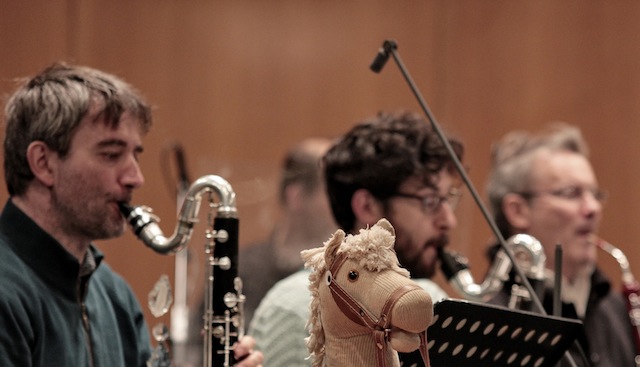
Georges Aperghis
— Situations, une convivialité musicale
— Situations, une convivialité musicale
I often think of an acrobat who balances from one tightrope to another or jumps and regains his balance at the last moment. I’m looking for this kind of fragility, this kind of danger.
– Georges Aperghis
The term convivium, which is threatened with extinction, is used by Georges Aperghis as the name for his great new work which he created between the beginning of 2012 and the summer of 2013 and which has been tailor-made for the 24 musicians of Klangforum Wien.
The piece demands a wide stage where the usual orchestral configuration will be interspersed with a colorful mix of easy chairs, assemblies of sofas, floor lamps, bookcases, and dinner tables to create a landscaped interior in which the musicians, in the course of the evening, will team up variously into freely formed groups. Over eighty minutes, the composition will change from stretches of chamber music to passages for soloists and up to groups of eight, verbal comments by individual musicians and also the whole ensemble. Situations is a concert piece, a soirée musicale for the 24 musicians of Klangforum Wien. The work takes the form of a triptych: the first part is an ensemble piece, put together by using fragments of diverse color and contrasting contents, which are arranged sequentially or superimposed upon one another so that changing polyphonies are constantly created.
The work takes the form of a triptych: the first part is an ensemble piece, put together by using fragments of diverse color and contrasting contents, which are arranged sequentially or superimposed upon one another so that changing polyphonies are constantly created.
At the end of the first part, the music becomes seemingly more individual; we are now faced with 24 solo players – which form the second part of the triptych. It is a mosaic of solo pieces, duets, trios and quartets that either stand by themselves or are performed simultaneously. The musicians move around the stage at will, at times keeping to themselves and playing on their own, or entering into a musical dialogue with others. Some play and sing at the same time, others might pick up a book from which they’ll read a passage aloud. We no longer attend a concert, but participate in a soirée where the musicians seem to have forgotten that there is an audience that watches and listens.
This, too, is a fragmentary construct: outlines of the interpreters’ musical portraits merge or answer each other like in a wide-ranging conversation. Those who are currently not playing, listen to their colleagues, either sitting in an easy chair or on a sofa; at times they will participate in the music that evolves at that moment, at others they might comment, or they are simply present as if they were lost in their own thoughts.
This organized chaos gradually becomes more structured and leads to a massive movement which constitutes the third part, an ensemble piece, which refers back to the individual voices we heard in the second part, reinforcing them and allowing them to echo throughout the whole ensemble before the piece culminates in an erratic and piercing tutti.
As you can see, the piece changes shape three times. In the second movement, there appears to be something like an enlargement effect, as if one was approaching the musicians in order to get as close as possible to their personality. Gradually abandoning my original idea of writing a concerto grosso finally led me to this solution. (Georges Aperghis)
